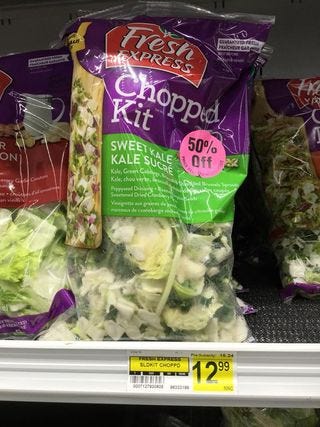What to do about the appalling food insecurity — and $50 vegetables — in Nunavut
Issue 206: In Canada's northernmost territory, where 83% of the population is Inuit, food insecurity is absurdly high, and traditional hunting is becoming more difficult.
Hello! Welcome to Nosh Box, a food newsletter. On Mondays, I send a reading guide of food system ideas, and on Thursdays, I dig deeper with an original essay or conversation you can only find here.
Check out Monday’s dispatch: A TikTok farmer takes us inside the world of out-of-season onion storage

In a viral Twitter thread this week, a resident of Igloolik, a city in Nunavut, Canada, raised the issue of the absurdly high price of food there. Nunavut is Canada’s northernmost territory, and 83 percent of the population there identifies as Inuit. And some of these food prices are truly appalling. Take a look:
$13 for a head of cabbage. $27 for a jug of orange juice. $63 for a fruit tray. That’s nuts!!!!
People in Nunavut can’t afford this! And this problem is not new. A 2014 report by the Action Canada Foundation found that almost 70 percent of Nunavut families are food insecure — six times higher than the Canadian average.

How did this situation come to be? Per the Action Canada report:
Southern interest in the North had a devastating impact on Inuit culture, including the ability of Inuit to feed themselves: residential schools removed children from their families, erasing traditional knowledge; relocations into permanent communities sometimes thousands of kilometres away from familiar animal migration patterns marooned hunters; expectation of a sedentary lifestyle coupled with a lack of wage-based labour encouraged idleness, often leading to alcohol and other abuses.
One consequence of this history is that hunting is no longer an ordinary and expected part of every Inuk’s life. As a result, Inuit today rely mainly on store-bought food, much of it high in salt, sugar, and unhealthy fats, shipped north at an astronomically high cost.
Once food products arrive in Nunavut, the sticker price generally runs 140 percent higher than the average Canadian price — and that’s if the food is even still good! Some fruits and vegetables arrive in such bad shape that they’re practically inedible.
The solution is going to have to focus on improving access to traditional, local “country foods,” which — according to the Nunavut Ministry of Health — are actually quite nutritious and contain a variety of essential vitamins, minerals, protein, omega-3s, and more. These include seals, arctic char, polar bears, beluga whales, arctic hares, berries, and wild plant greens.
But unsurprisingly, it’s more complex than just telling people to “eat local food.” To get these animals, people often have to hunt them themselves. As the Action Canada report points out, younger generations don’t always have the specialized harpooning, fishing, and preparation skills their grandparents did. Nor do they have access to industrialized equipment like snowmobiles, which have largely replaced sled dog teams in common usage. This hunting gear is difficult to transport to Nunavut, and like food itself, it’s super expensive. An “all-season” hunting outfit — boat, snowmobile, ATV, gun — runs more than double the median annual income.
And let’s talk about systemic challenges, too. In yet another example of the injustice that the greatest impacts of climate change will fall disproportionately on those who did the least to cause it, the threat of climate change in Inuit communities — and the fact that 95 percent of the Arctic’s oldest ice has melted in the past 30 years — looms large. And in the name of animal rights, advocacy organizations like Greenpeace Canada have launched anti-seal hunting campaigns that, despite retractions and apologies, continue to negatively impact Indigenous groups. In 2009, the European Union banned the trade of commercially harvested seal products, which contained an exemption for Indigenous hunters but still tanked the seal pelt market and made it difficult for Inuit hunters to earn money. And Inuit folks still regularly face online harassment in the name of veganism and animal welfare.
But as @KataraPiujuq, the woman who posted the initial Twitter thread on food prices, points out, the Inuit culture is not one of exploitation but respect for animals and resources:

Over the past couple years, Alaskan photographer Acacia Johnson has been documenting Inuit life through the lens of hunting practices — for food, yes, but also for pelt to stay warm, for oil to use as lighting and cooking fuel, and for materials to make clothes and woven items to sell.
The images Johnson shared in this photo essay for North Country Public Radio are truly spectacular and show not only the complexity of obtaining food but the joy in sharing it and eating together. She shows the importance of food community to Inuit culture and notes that Facebook has become a platform for food sharing as well: People post extras from their hunts and join groups and organizations like Feeding Nunavut, Feeding my Family, and Helping Our Northern Neighbors.
I encourage you to look through the photos here!
And to the central issue of food insecurity and exorbitant food prices in Nunavut, what should be done to address it? The Action Canada report I mentioned earlier calls for funding for hunting equipment and training programs, improving local food distribution infrastructure, and supporting local food security coalitions. Leesee Papatsie, the founder of the Feeding my Family group, also outlined several solutions she thinks would be helpful, including regulating grocery pricing and subsidizing foods that are part of Northern Canadians’ traditional diets. And if you feel so inclined, Feeding Nunavut has a guide to local organizations that could use donations right about now.
“We've got to find ways that work in the North,” Papatsie told North Country Public Radio. “What's already working in the North is Inuit culture — harvesting, sewing, making art. So it's not reinventing the wheel but working with the wheel that's already there.”










